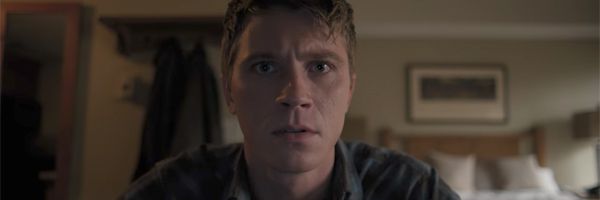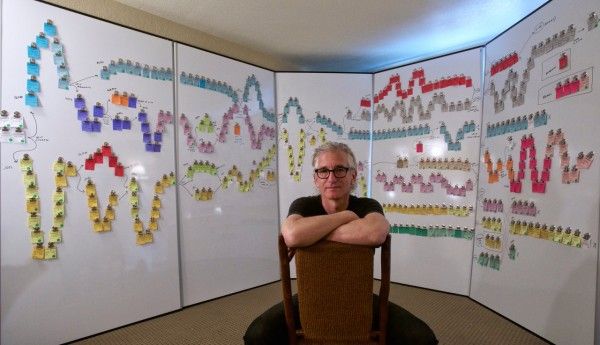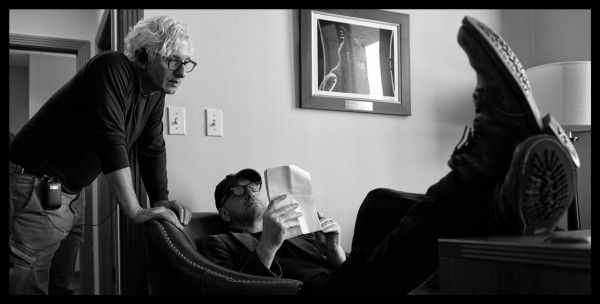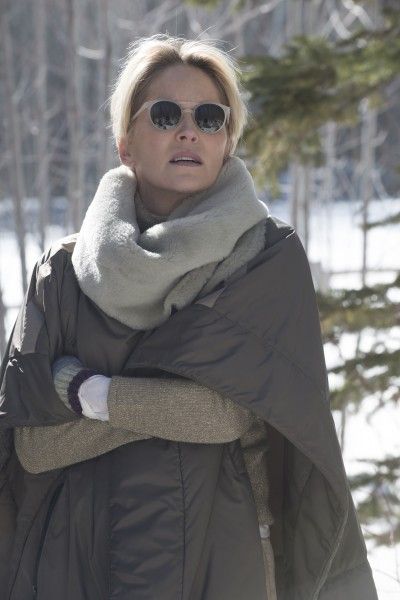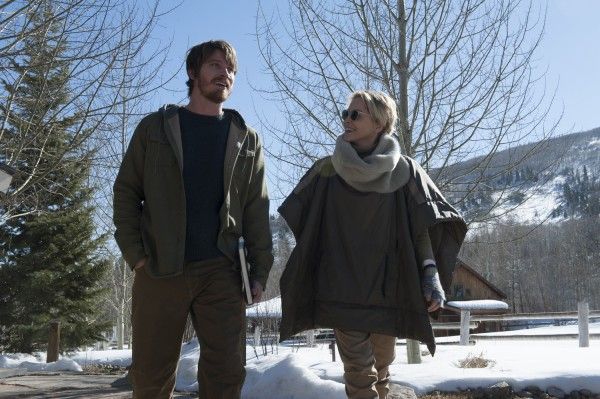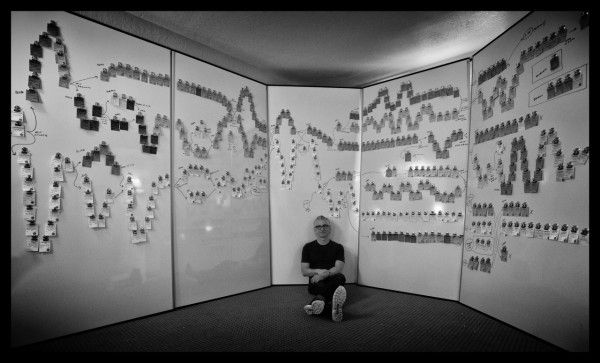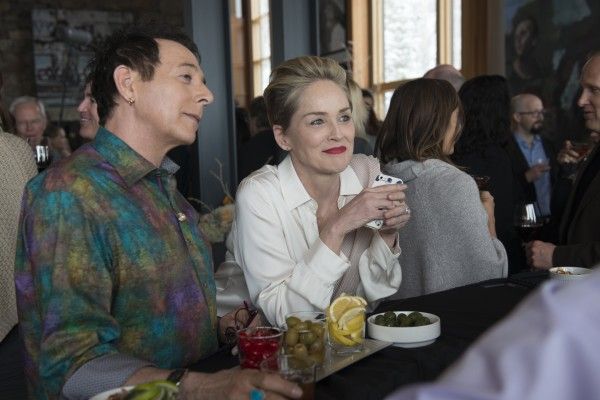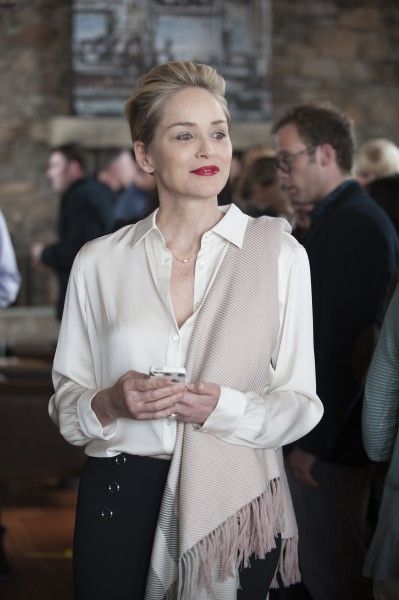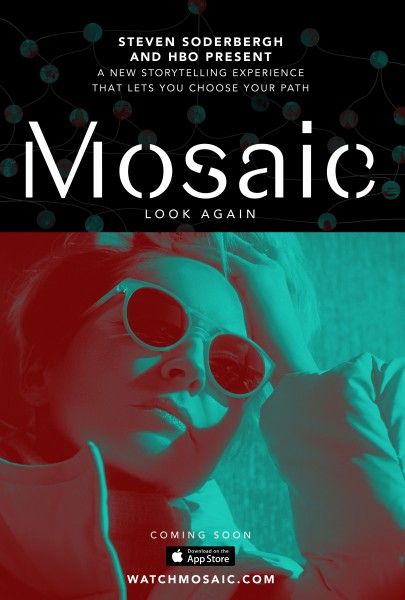The art of telling stories has existed for thousands and thousands of years. The art of telling stories as moving pictures has been around for over a hundred years. In that time, the artform has evolved and changed, with new artists pushing the boundaries of what was possible to reach new heights and break new ground. Given the sheer volume of films, short films, TV shows, limited series, and even video games, one might understandably think it’s nigh impossible to find a genuinely new way to tell a story. But leave it to Steven Soderbergh to do just that.
Mosaic is the secretive HBO project that was first touted as Soderbergh’s “coming out of retirement” movie, but the Ocean’s Eleven filmmaker was quick to correct that Mosaic was not a movie. It wasn’t a TV show either. In fact, it’s a “branching narrative,” utilizing new technology that allows viewers to choose how they experience one story.
Soderbergh developed the tech for Mosaic with producer Casey Silver, but when it came to actually coming up with and writing the story, they turned to Ed Solomon, the screenwriter behind films like Men in Black, Bill and Ted’s Excellent Adventure, and the Now You See Me movies. Solomon jumped at the chance to partner up with Soderbergh and attempt something that had never been attempted before, and the result is a thrilling, twisty, and artful murder mystery set in a quiet ski town starring Sharon Stone and Garrett Hedlund.
Solomon spent six months outlining the story for Mosaic and another six months actually writing the screenplay, and when more money was needed to make the app available on Android and desktop in addition to iOS, Solomon and Soderbergh were tasked with crafting a linear six-episode limited series cut of Mosaic to air on HBO. That limited series starts airing Monday, January 22nd at 8pm ET on HBO with the other episodes debuting on subsequent nights, culminating with the final two episodes back-to-back on Friday, January 26th at 8pm.
I’ve seen the limited series cut and the app and can personally attest that both are quite different from one another, but are equally a joy to experience. Soderbergh directs the entire thing with the intimacy we’ve come to expect from his work, the performances are phenomenal, and Solomon's script is rich in character, intrigue, and humor.
With the limited series cut of Mosaic airing on HBO, I recently got the chance to speak with Solomon for an exclusive, extended interview about the project. During the wide-ranging conversation he revealed in great detail the origins of Mosaic, how he and Soderbergh went about plotting out this new kind of storytelling, what they learned along the way, and how the limited series cut differs from the app version of the story. Solomon also teased two additional branching narratives that are in the works.
The full interview is a wildly insightful and candid discussion, and Solomon spares few details in recounting his experience with a project about which he clearly feels passionately. And for good reason, because while it sounds like Mosaic was a bear to actually put together, the final result is well worth the effort.
Check out the full interview below, and check back on Friday night after the finale for Solomon’s spoilery thoughts on how the story’s conclusion was crafted.
How and when did all of this start? When did this idea first come to fruition?
ED SOLOMON: Four years ago the producer Casey Silver and one of his partners at the company that was underlying all of this, Mindsight Media, they called me and said, ‘Do you wanna meet for breakfast?’. I said, ‘Sure,’ and they said, ‘Okay, but you’ve gotta sign an NDA at the breakfast,’ and I was like, ‘What?! These must be really special omelets!’ (laughs). It was because they had been working with Steven on developing this technology that would allow viewers to have a choice, to follow a certain path or another path. They wanted to talk to me about it but they wanted to make sure that I would keep it a secret. So we went to breakfast and they said, ‘We have this technology and we wanna try to develop a short prototype with Steven Soderbergh. Are you interested?’, and I said, ‘Of course I’m interested.’ I love Steven, I’ve loved his work. I like him as a person but we’d never worked together in any depth. And then also the idea to do something fresh and brand new, I couldn’t resist.
So about four years ago, November of 2013 I think, Steven and I started talking and throwing ideas around for this 10-minute film that he was toying with. It was a whole different story than Mosaic, but took place in the lobby of a hotel and you could follow a couple checking in or the people that work in the hotel, and everyone had slightly different stories. It was not an attempt to tell a story it was more an attempt to see if this notion of delivering a story in this fashion would work. So then Steven shot it, and he liked what he had and decided he wanted to do something longer with it. He was in a meeting with Richard Plepler at HBO and showed him the 10-minute prototype, and to Richard’s credit he said, ‘I’m not gonna let you leave the room until you agree to do this with us.’ So HBO took a giant leap. There was no story yet, no idea even, just simply faith in Steven to deliver something at HBO’s quality.
So in the late summer/early fall of 2014, Steven said, ‘Hey I’m thinking about doing a longer version of this, what kind of notions would you think about?’ There are a variety of stories that I’ve always been really interested in telling, and we started working on throwing some ideas around a little bit about this notion that I’d always been playing with in my head, which was what if somebody had to investigate a death and gradually it began to dawn on this person that he or she was potentially culpable in the death? Initially it was a woman character that I was thinking about.
Then we talked and threw some ideas around, and I didn’t hear anything for a couple of months because we were both working on other things, then he called me and said he’d be in town in November, and we met up and he said, ‘Okay HBO wants to do this. Are you interested in writing it?’ and I said, ‘Yeah for sure, 100%. Do you want to go with the story I was talking to you about?’ and he said, ‘Kinda yeah. What I’m interested in is a murder in a small, resort-type town, somewhere where a larger-than-life character, a woman, is murdered and then maybe some time has passed and now we come back to reinvestigate the murder.’ That was kind of his initial notion and I started to sort of riff on it a little bit, then I went away to think about it and the very first text I sent about it was, ‘What if it’s a woman who’s an illustrator who awoke from a dream with an idea for a children’s book, wrote it down in 45 seconds, and then in two weeks illustrated it and it became like Where the Wild Things Are? It was huge, it made her rich, and it made her famous, but she could never get back to that again. And because she came up with it in a dream it was both her idea but also a thing she didn’t have any agency over, it just kind of happened to her, so she never could quite recapture it.'
The reason I was thinking that was he wanted to set this in a ski town, and a lot of these ski towns were old mining towns up in Colorado or Utah, so I thought that was a really interesting theme of stuff bubbling under the surface, and then the thawing ground, and what would happen if she was buried somewhere down in the mountain and in the thaw—in fact my original working title for this was The Thaw—what if in the thaw her hand appears and that reopened this murder? He said, ‘That sounds great, let’s keep going with that.’ So it was built out of the Sharon Stone character, who’s now called Olivia Lake.
In fact the Olivia Lake character was originally called Sharon because we thought the perfect actress to play the part would have been Sharon Stone, and of course it ended up being Sharon. She gives such a heartbreaking, gut-wrenching performance in this. She’s wonderful.
So then I started writing and I told Steven don’t worry about geography, I’ll be where you need me when you need me, and I worked from L.A. building the story and I came to New York once a week, sometimes once every other week, and sometimes a couple times a week. I pitched out everything I thought of, he and I would throw it around in the room, and then I’d leave and go back to L.A. and work for another week or so. We did that for about three or four months. I had to finish a movie project, so about February, March, April, May of 2015 I was doing this commute. Steven said, ‘Hey, as long as we have this thing fully outlined by June I’ll know what we’re making and I can commit to doing it,’ and in June we had about 500 cards up on a giant wall. We had this giant office in New York, one room that was all whiteboard, and we had a giant outline all on the wall.
So I said, ‘When are we shooting?’ and he was like, ‘I have a window in November, let’s shoot the present day stuff before the snow, then we’ll let the actors gain weight and grow facial hair and stuff and shoot the past stuff in the snow after the New Year, so it’ll give a visual distinction between the present and the past,’ and I was like, ‘Wait, November? This is gonna be six or seven hours long, and it’s June! We’ve only got an outline and we’re gonna start shooting in November?’ But I was super inspired and super jazzed and excited to go and write, and to be honest in a way, writing something on a more sprawling canvas is actually more freeing and less restrictive and kind of in a weird way goes faster than trying to shoehorn everything into a 100-minute movie script.
But also, the thing that takes movies so long to write is the chorus of voices, the committee—literally—of people telling you what they want it to be and what it needs to be, that’s what slows it all down. When you have somebody like Steven saying, ‘Let’s dig deep. Let’s make this thing interesting. Let’s make it unusual. Let’s make it real life. And let’s make it artful.’ It’s an entirely different process and in a weird way it’s so much more freeing, and because it’s more freeing it’s easier, you can write faster because you can write deeper.
So in that process, because you only had a few months to write it, did you have to just commit to things instead of having the time to second guess yourself? Did the characters or story change much as you were writing the script?
SOLOMON: Well bear in mind, the real heavy lifting is always in the outline. So from February to June I’m collaborating with Steven on a giant outline, and he actually said to me—and I don’t know if this will translate into text, but he said, ‘Look if we have every scene indexed and structured, all that’s left to do is the writing.’ (laughs). I understood exactly what he meant. One of the many things I love about working with him is he sees his role as director to bring out the essential “it-ness” of whatever “it” is trying to be. Meaning whatever this piece is that I’m working on, he would say, ‘I want it to be the optimal manifestation of itself,’ and his job is to mute the things that aren’t it and to bring forward the things that are it. And that’s great because it allows you and he to have a collaboration as creator with the thing that’s being created as it’s being created. It’s a whole other way of working than, for instance, the studio way of working.
So I worked all year on this thing, from January 2015 and then I was writing script pages from our outline starting in June through July, August, and September. We went up in October, I think, to Park City to film, and because there was so much to write and because we were shooting it in two sections, we broke it up so that I wrote all the present tense stuff first so we’d have it while we were shooting. And then while we were on set shooting I did two types of writing: One type of writing was writing the past tense stuff that was coming up, that we were gonna start shooting in February, and the other was all the new ideas we were getting shooting. Because the form was new to us, and because there had not been any work of this scope done in a form like this before—especially at a level like Steven—there were no precedents. So because of that, as we were going forward we started referring to it as bushwhacking. As we were sort of bushwhacking we were learning so much as we were going forward. Every week we’d have a giant epiphany. Sometimes it was, ’Oh man, what if we did this and added a scene like this?’ and then I’d go off and write it and come back with it. Sometimes it was, ‘Next time we gotta do this,’ or ‘Oh we should do more of this!’
Also we found stuff that we thought was gonna really be fascinating just wasn’t as fascinating as we thought, and sometimes we thought stuff that we just did in passing, just as a little nuance to something, turns out to have warranted a whole special sequence based on that. We just were learning. I think the script was like 250 pages going into the fall shoot, and we added a whole 100 pages to that during production. And then the second half script was 150 pages, so I think it was about 500 pages by the time it was done, and with more stuff than we needed at the end of the day. We added so much then we ended up cutting a lot of it out and shaping, honing it in post-production, because again we were kind of teaching ourselves this form.
I know Steven has referred to it as the cave painting version of this form—I’m talking about the branching narrative version, which is different from the linear version. But it’s obviously the same story, and I think this is actually an important point in terms of the transition of it from an app where you pick a path and follow it to a linear HBO limited series. In designing this, we had to design a story that could be told from multiple directions, and that doesn’t mean every direction because that would imply there’s a randomness to the narrative which is really not true, but there is truth to the idea that when you design a story it really is great to remember that every character in your story should be drawn richly enough to have their story warrant a movie in and of itself. The way we designed this was we put it up in this room, it occupied all four walls of this large office. We put it all up in the order the events happened, and then we sat in the middle of the room and then pulled the index cards off of the wall that contained the chronological order of events and then put them up on another wall in the narrative order.
That was one of my questions was how you shaped the story. It sounds like you just kind of blew everything out, then you had the chronological order of events and then you decided how that would best flow as a narrative experience on the app?
SOLOMON: Yes. Exactly. Because there was no randomness to that at all, it was very curated.
I watched the whole linear version and then I fired up the app, and I was surprised to find that it starts very differently and in a different place. So I was curious how that linear cut changed the story you were telling, or did it? How did you go about crafting a linear version of this story?
SOLOMON; Yes, interesting. We have two things running simultaneously in the conception of this. One is we want this story to be able to be told from multiple points of view, but by the same token we want any choice people make to be optimal for that path that they’re on, we don’t want it to be random. So we spent a lot of time in editing figuring out what the optimal way to do the app version was. It was just trial and error, because a lot of the stuff that we had conceptualized and we thought would work, as I was saying, didn’t always work as well as we thought and vice versa, some things that we thought were passing notions actually turned out to be fascinating and we wanted to focus on them. So that required us to rework the app quite a few times before we ended up with what we ended up with, and one of the main things we ended up with was a gigantic wellspring of knowledge as to, ‘Well next time we do this, oh my God we are so far down the road in terms of new ideas to utterly maximize this format.’
So that’s one thing we left with. But then the other thing was, there was a decision made to provide a linear cut for HBO. Steven is the director, DP, camera operator, and the editor, so you don’t watch dailies, you watch cut footage. And at some point in this process they were looking at cut footage and putting it into the rudimentary prototype for the app, and they realized that to HBO’s credit, they wanted to have it out in more markets than just the iPhone, they wanted it out to Android and the desktop. But in order to do that the tech people needed more money, to reach more people, so HBO said, ‘We’ll give you more money but would you give us a linear cut so we can also put it on regular HBO?’, because it wasn’t initially gonna be on regular HBO. So Steven said, ‘Let me see if I can figure out a way to do a linear version that would actually feel like its own entity.’
So then it became a rebuild. If you’re going to do it where you’re not making choices but the filmmakers are leading you through one story, how would we break that up? So it was a matter not just of reordering the sequences of the app and putting it into a straightforward narrative, it was actually let’s rebuild scene by scene, shot by shot. How would we tell this story if we were just leading someone through? So that’s why in the linear cut it starts with Joel and Nate and you’re asking the question, ‘What is their relationship? Who is this guy Joel? What did he do wrong?’ It sort of leads you into the story. But in the app version we start with Sharon Stone. Why did we do that? Well, we initially started the app version with Joel, Garrett Hedlund’s character, not in the situation where you start the linear cut but rather Joel’s in Louisiana, he’s running a tourist alligator hunting facility. Someone arrives, Petra, the sister of this guy who’s been imprisoned, and says, ‘Can you please come back to Summit, Utah, I need help proving his innocence?’ He vowed never to go back to Utah but she needs his help, and then that was the first split. But what we found was people didn’t know either character well enough to know how to make a choice. The way we had initially structured it you got to know Olivia as you went through the story, so what we did was we went back to the boards, how we originally designed it. Remember how I said it started with Olivia, in the conception, so Steven made the decision let’s start with Olivia, really get to know her, get invested, spend like a whole episode’s worth of time with her, and then when you start to know who the characters are you have to make the first choice.
That was why we began with Olivia in the app version. In the linear cut, in the design of the whole piece overall—this is not Agatha Christie with 12 different potential suspects, but we wanted it to be a small amount of people that you’re wondering about. So he built it around that structure, which is different.
There are more of these branching narratives in the works too right?
SOLOMON: There’s one being developed right now at HBO that I’m not writing but a woman named Karrie Crouse is writing that one, she's great. She’s writing this piece that has more of a young teenager sort of feel to it, and because of that there’s a lot of social media stuff that happens. So there’s the narrative and then there are other layers of the story that take place in all these social media outlets, which is really cool but it’s very organic to the nature of the story itself. The other one that I’ve written—actually I spent all of last year writing a new one, it’s almost done, with the partnership of Steven and Casey again. It’s simpler in certain ways but it is by orders of magnitude more complex in terms of our new understanding of this form having been through what we went through. From pre-production to production to post-production we learned so much, and by the way the next one will be even more so and other filmmakers will come in I hope and add in their stuff and hopefully people will keep building and building on this so people will get better and better with it.
Is the one you’re writing now another murder mystery?
SOLOMON: It’s not a murder mystery. There’s a thriller aspect to it for sure, but no it’s not a murder mystery. There’s a lot of mystery in it, but it’s not a murder mystery. It’s a genre in and of itself in a way. Again, having gone through it once it was so, so, so much easier to think not of ‘How would I write a 6-hour movie and then chop it up into a branching narrative piece?’, but rather now that I’m thinking in branching narrative form, how do the ideas come that will really serve this form? It’s a whole different experience for me. I kind of feel like all the work, all the success, all the failure, all the heartbreaking, all the rejected drafts, all the rewriting I did for the first three decades of my career led me to Mosaic. The challenge is doing Mosaic and the incredible gift of being able to experience a form in the way that I experienced the form of film writing or television writing when I was first starting, meaning I wasn’t familiar with the rules, I had no experience with the form itself, I didn’t have a lot of pages under my belt so it was all brand new, and there’s a kind of excitement that you both feel personally but also comes forth in the pages that you write. So having that gift three decades in to get to try something like Mosaic and work as hard as we worked on it, I feel like I wouldn’t have been able to do this new one if I didn’t have that three decades of other work and then three years of Mosaic under my belt.
And now I’ve done this new one that’s 700 pages long, and it was a great experience. I couldn’t ask for a better partner than Steven who is just brilliant and trusting and calm and supportive and challenges you but supports you. It’s the greatest way to work.
Is he going to direct that one and the other one that deals with social media?
SOLOMON: He’s not directing either, he’s producing those.
This interview has been edited and condensed for clarity.

